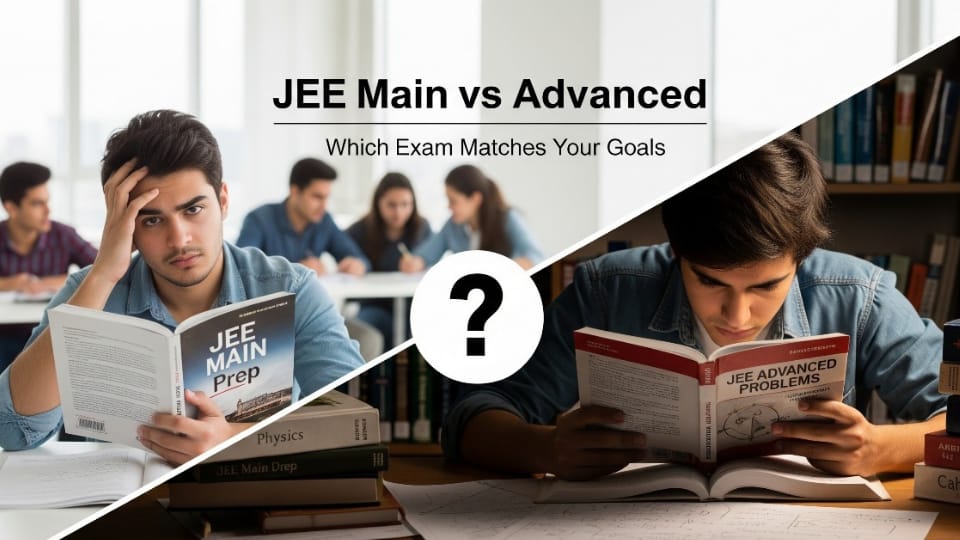Navigating the jee main and advanced difference is crucial when over 1.73 lakh students compete for just 13,853 IIT seats nationwide. While both exams are gateways to prestigious engineering institutions, they serve distinctly different purposes in the admission process. JEE Main acts as the qualifying exam, allowing only the top 2.5 lakh rank holders to attempt JEE Advanced, which is specifically the entrance test for the coveted IITs.

When it comes to exam frequency and attempts, we’ve found significant variations. JEE Main is conducted twice annually (January and April), allowing students up to 6 attempts over 3 years. However, JEE Advanced happens just once a year with only 2 consecutive attempts permitted. Furthermore, the difficulty level presents another stark contrast—JEE Main primarily tests your understanding of Class 11 and 12 concepts, while JEE Advanced is renowned for its elevated difficulty. With nearly 9,21,261 students expected to appear for JEE Main and only 2,50,000 qualifying for Advanced, understanding these differences isn’t just helpful—it’s essential for strategic preparation. In this comprehensive guide, we’ll break down everything you need to know about both exams to help you align your preparation with your engineering aspirations.
Understanding the Fundamental Differences Between JEE Main and Advanced
The fundamental jee main and advanced difference begins with their organizing authorities. JEE Main is conducted by the National Testing Agency (NTA), whereas JEE Advanced is managed by different IITs on a rotational basis each year. This distinction reflects their separate purposes in India’s engineering admission ecosystem.
Conducting Bodies: NTA vs. IITs
JEE Main falls under the National Testing Agency’s jurisdiction, which standardizes the examination process across the country. In contrast, the responsibility for JEE Advanced rotates among the IITs annually, allowing each institute to contribute to the examination’s development. This rotation system ensures the exam maintains its challenging nature through varied perspectives and approaches.
Eligibility Requirements and Number of Attempts
One critical difference between JEE Main and JEE Advanced lies in their eligibility criteria. For JEE Advanced, candidates must rank among the top 2,50,000 JEE Main qualifiers. Additionally, JEE Advanced permits only two attempts in consecutive years, unlike JEE Main which allows six attempts over three consecutive years.
Regarding age restrictions, JEE Main has no specified age limit. Conversely, JEE Advanced requires candidates to be born on or after October 1, 2000, with a five-year relaxation for SC, ST, and PwD candidates.
Exam Structure and Question Format
The exam structure presents notable differences as well. JEE Main follows a consistent format with predictable question types, primarily multiple-choice and numerical questions. On the contrary, JEE Advanced’s pattern varies annually, featuring a complex mix of multiple-choice, numerical value, and comprehension-based questions.
Both exams cover Physics, Chemistry, and Mathematics, but JEE Advanced incorporates more sophisticated problem-solving requirements across two mandatory papers of three hours each.
Difficulty Level: What Makes JEE Advanced Harder
JEE Advanced stands apart primarily due to its elevated difficulty level. Unlike JEE Main which tests fundamental concepts and application, JEE Advanced demands in-depth understanding and analytical thinking. The questions require creative problem-solving approaches and often combine multiple concepts within a single problem.
Moreover, JEE Advanced is internationally recognized as one of the world’s five most challenging examinations. Its selection rate of approximately 1.6% compared to JEE Main’s 21-25% further illustrates the significant difference in difficulty between these two crucial engineering entrance examinations.
Comparing the Syllabus and Exam Pattern
Beyond mere testing methods, the jee main and advanced difference extends significantly into their syllabus content and examination formats. These variations are essential for tailoring your preparation strategy effectively.
Subject-wise Syllabus Comparison
The JEE Main syllabus primarily encompasses Physics, Chemistry, and Mathematics topics from CBSE Class 11 and 12 curriculum. Although both exams cover the same core subjects, their content focus differs considerably. JEE Main includes topics like Electronic Devices and Electromagnetic Waves that are absent in JEE Advanced.
Conversely, JEE Advanced introduces additional advanced topics beyond the standard curriculum. For instance, Thermal Physics and Electrochemistry are part of JEE Advanced but not covered in JEE Main. JEE Main emphasizes areas such as Sets, Relations, Functions, Statistics, and Probability, which are not included in the JEE Advanced syllabus. This difference highlights the need for specialized preparation depending on your target exam.
Marking Scheme and Negative Marking
JEE Main employs a straightforward marking scheme—four marks for each correct answer and one mark deduction for incorrect responses to MCQs. For numerical value questions, four marks are awarded for correct answers with no negative marking for incorrect ones.
In contrast, JEE Advanced implements a complex marking system that varies annually. It features full marks, partial marks, and negative marking based on question types. Particularly, multiple-correct MCQs follow an intricate scheme where partial credit is given based on the number of correct options selected. This sophisticated system requires strategic answering approaches.
Time Duration and Paper Structure
Both examinations allocate three hours per paper. Nevertheless, JEE Main comprises a single mandatory paper for B.E./B.Tech aspirants, whereas JEE Advanced consists of two compulsory papers, each requiring three hours.
JEE Main Paper 1 contains 75 questions divided equally among Physics, Chemistry, and Mathematics (25 questions each). Meanwhile, JEE Advanced divides its papers into multiple sections featuring diverse question formats. The total marks for JEE Advanced is 306, with each paper carrying 183 marks.
Types of Questions in Each Exam
JEE Main primarily features multiple-choice questions (MCQs) and numerical value questions (NVQs). In total, each subject contains 20 MCQs and 5 NVQs.
On the other hand, JEE Advanced incorporates a wider variety of question formats, including single-correct MCQs, multiple-correct MCQs, numerical answer type questions, and matching-type questions. Furthermore, JEE Advanced includes paragraph-type questions with numerical answers, demanding comprehensive understanding and analytical problem-solving abilities.
Admission Opportunities Through Each Exam
The jee main and advanced difference becomes most apparent when examining where each exam can take you. The distinct admission pathways represent the core purpose behind this two-tier system.
Colleges Accepting JEE Main Scores
JEE Main serves as the gateway to 31 NITs, 25 IIITs, and 38 GFTIs nationwide. Additionally, numerous state universities and private colleges accept these scores. Notably, the examination provides entry to prestigious institutions like NIT Trichy, NIT Surathkal, and NIT Warangal.
IITs and Other Institutions Through JEE Advanced
JEE Advanced exclusively facilitates admission to 23 IITs across India. Indeed, this examination remains the only path to securing a seat at these elite engineering institutions. In 2025, 54,378 candidates qualified for JEE Advanced, competing for approximately 18,160 sanctioned IIT seats.
Seat Availability and Competition Analysis
The competition ratio stands at roughly 3:1 for IIT seats, with approximately three qualified candidates vying for each available position. Consequently, even after qualifying for JEE Advanced, admission isn’t guaranteed. First-generation IITs like Bombay, Delhi, and Madras remain the most sought-after, with 73 of the top 100 rankers choosing IIT Bombay in 2025.
Ranking System and Cutoffs
Admission cutoffs vary significantly based on institute prestige and program. For instance, Computer Science at IIT Bombay closed at rank 68 in 2024, whereas newer IITs admitted students ranked beyond 6,000. Furthermore, category-wise cutoffs provide relaxations—35% aggregate marks for general candidates versus 17.5% for SC/ST/PwD candidates.
Preparation Strategies Based on Your Target
Strategic preparation is essential when considering the jee main and advanced difference, as your approach must align with your specific goals. Your preparation journey requires careful planning and execution.
Creating a Study Plan for Both Exams
First thing to remember, develop a personalized plan covering all three subjects with allocated time based on your strengths and weaknesses. Break down your syllabus into manageable daily targets to maintain focus while ensuring realistic goals. Understand both exam patterns thoroughly prior to creating your schedule.
Resource Selection: NCERT vs. Advanced Reference Books
NCERT textbooks are absolutely fundamental—master these before exploring advanced references. For JEE Main, NCERT provides strong conceptual clarity, especially in Chemistry. Subsequently, supplement with specialized books like HC Verma for Physics and RD Sharma for Mathematics for Advanced preparation.
Time Management Techniques for Dual Preparation
Essentially, dedicate 6-8 hours of focused study daily. Incorporate short breaks to enhance memory retention and maintain concentration. Identify your peak learning hours and schedule challenging topics accordingly. Create separate time blocks for practice, revision, and doubt-clearing.
Mock Tests and Performance Analysis
Regular mock tests simulate real exam conditions and should ideally begin 2-3 months into preparation. After each test, analyze your performance by identifying incorrect answers and understanding conceptual weaknesses. Track your progress over time to recognize patterns and improvement areas.
Common Preparation Mistakes to Avoid
Frequently, students make these critical errors:
- Neglecting NCERT fundamentals before advanced concepts
- Overlooking regular revision of previously studied topics
- Focusing excessively on theory without sufficient problem practice
- Avoiding timed mock tests and performance analysis
- Neglecting health and sleep requirements
Success Stories: Learning from Toppers
Top JEE rankers like Vavilala Chidvilas Reddy (AIR 1) studied consistently from 6am to 11pm. Most successful candidates begin preparation in Class 9 or 10. Toppers emphasize conceptual clarity over rote memorization. Their resilience in bouncing back from setbacks stands out as a common trait.
Conclusion
Understanding the fundamental differences between JEE Main and Advanced therefore becomes crucial for every engineering aspirant. Throughout this guide, we’ve examined how these exams differ in terms of conducting bodies, eligibility criteria, attempts allowed, and difficulty levels. JEE Main serves as a qualifying exam for NITs, IIITs, and GFTIs, while JEE Advanced remains the exclusive gateway to the prestigious IITs.
The stark contrast in difficulty levels cannot be overstated. JEE Main tests foundational knowledge and application of concepts, whereas JEE Advanced demands analytical thinking and creative problem-solving skills. Consequently, your preparation strategy must align with your specific goals and capabilities.
For students aiming for NITs or other reputed engineering colleges, focusing primarily on JEE Main might be the practical approach. However, those dreaming of IITs must prepare for both exams simultaneously, understanding that Advanced requires a deeper conceptual grasp and more rigorous practice.
Above all, success in either exam demands consistent effort, strategic planning, and disciplined execution. We’ve seen how toppers dedicate structured hours daily, prioritize conceptual clarity over memorization, and maintain resilience through setbacks.
Your choice between focusing on JEE Main or pushing for Advanced ultimately depends on your career aspirations, academic strengths, and personal circumstances. Regardless of which path you choose, starting early, mastering NCERT fundamentals first, and regularly testing yourself through mock exams will significantly enhance your chances of success.
The engineering entrance journey is undoubtedly challenging, but with clear understanding of these exams and dedicated preparation, you can indeed achieve your academic goals and secure admission to your dream institution.
FAQs
Q1. What is the main difference between JEE Main and JEE Advanced? JEE Main serves as a qualifying exam for NITs, IIITs, and GFTIs, while JEE Advanced is the exclusive entrance test for IITs. JEE Advanced is significantly more challenging, requiring deeper analytical thinking and creative problem-solving skills.
Q2. How many attempts are allowed for JEE Main and JEE Advanced? JEE Main allows up to 6 attempts over 3 years, with the exam conducted twice annually. JEE Advanced, however, permits only 2 consecutive attempts and is held once a year.
Q3. What is the syllabus difference between JEE Main and JEE Advanced? While both exams cover Physics, Chemistry, and Mathematics, JEE Advanced includes more advanced topics and excludes some areas covered in JEE Main. The Advanced syllabus is generally more comprehensive and challenging.
Q4. How does the marking scheme differ between the two exams? JEE Main has a straightforward marking scheme with 4 marks for correct answers and 1 mark deduction for incorrect MCQs. JEE Advanced employs a more complex system with varying marks and partial credit options, depending on the question type.
Q5. What preparation strategy should I follow for these exams? Start with mastering NCERT fundamentals before moving to advanced concepts. Create a balanced study plan covering all subjects, practice regularly with mock tests, and analyze your performance. Aim for 6-8 hours of focused study daily, and start preparation as early as possible, preferably from Class 9 or 10.

